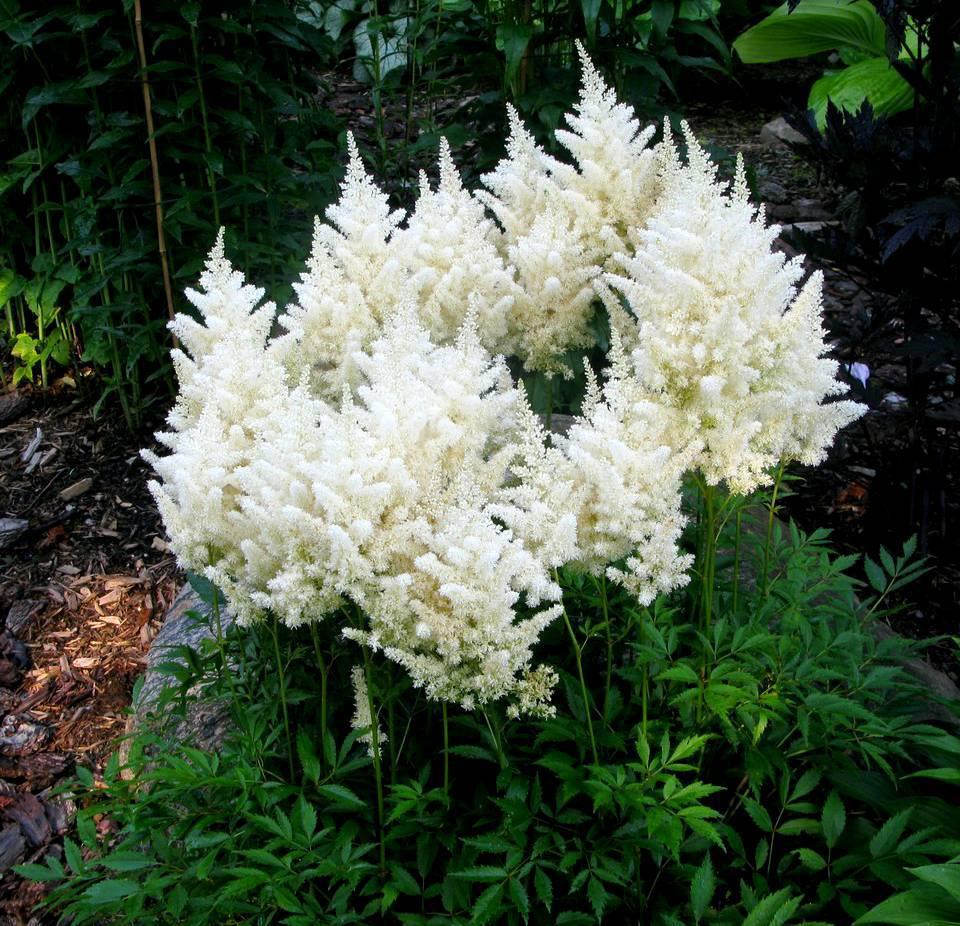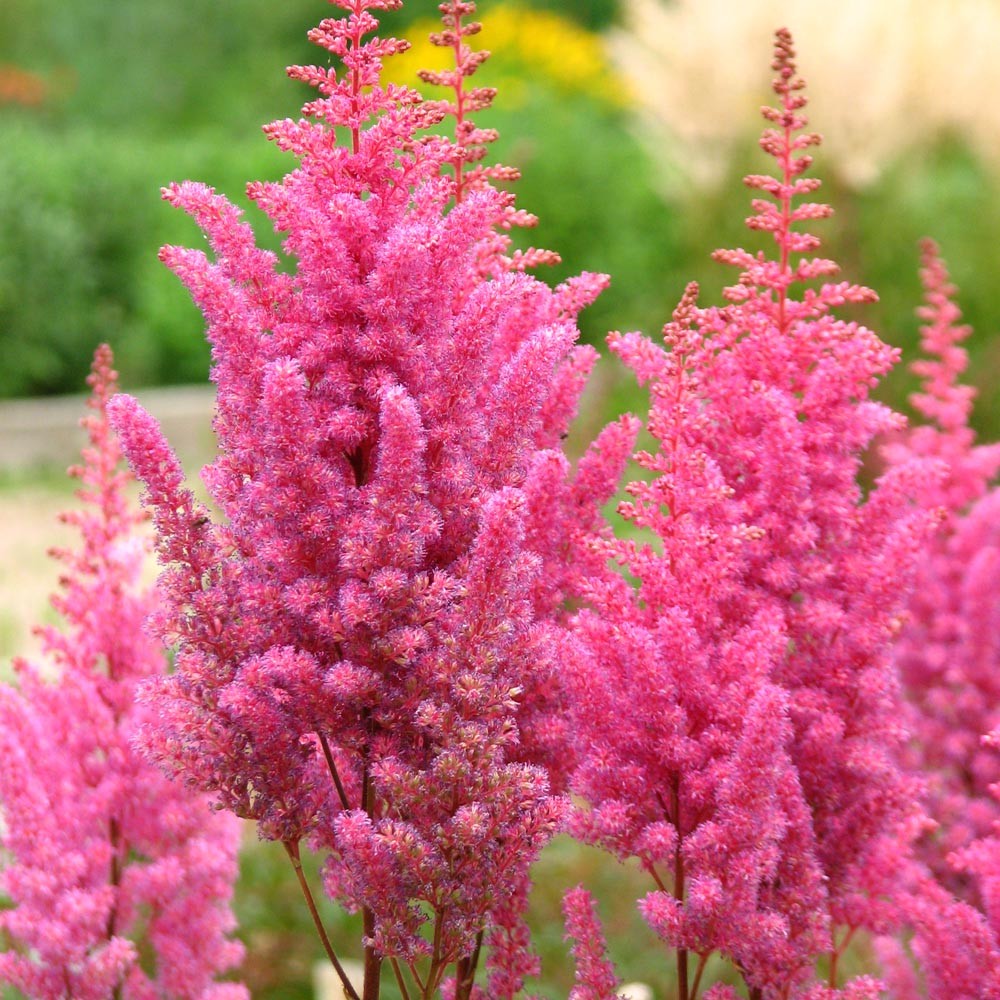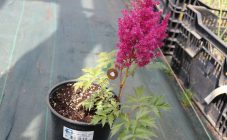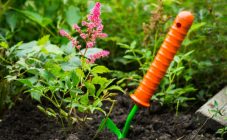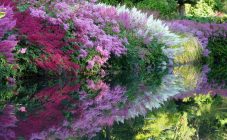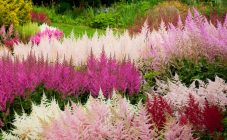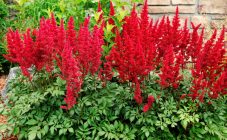All professionals and amateurs in the field of landscape design know about the unpretentious and spectacular astilbe flower. It is a perennial that has at least 40 varieties. For two centuries in a row, astilba has occupied an honorable place in public greenhouses and private garden plots.
Japan is considered to be the homeland of Astilba. It was from there that astilba was brought to Europe and America. Since the beginning of the 20th century, breeders around the world have bred new varieties and hybrids.
Popular varieties
Description of the most popular varieties of astilba in Russia:
- Astilba Gloria purpurea has bright pink inflorescences. A short plant - about 0.7 m in height. It stands out among other species with voluminous diamond-shaped flowers and brown foliage. Astilba gloria purpurea has the highest flowering density, so it can be used to create a picturesque hedge. The disadvantage of the species is the short flowering period.
- Weisse gloria Astilba (White Gloria) has been known since the 1920s. With a total bush height of 0.7 m, the foliage grows up to half a meter, so the plant looks very sprawling and powerful. Young tops have a delicate green color, as they develop, the shade becomes darker and deeper, and a brown border forms along the edge of the leaves. Also on the leaf itself there are brown specks. Inflorescences have a boiling white shade only 5-7 days from the beginning of flowering. Gradually the shade becomes more yellow.
- Astilba Lolipop is a hybrid that is compact and miniature in size. The total height of the bush is only 0.45 m. The plant retains its graceful shape for 3 seasons in a row. Flowers have a fairly rare coral shade. The foliage is also quite bizarre, with red pigment appearing in it. The leaves have a distinct glossy sheen and an unusual shape. These features distinguish this variety from all the others.
- Astilba Garnet was launched in 1920. The plant is very large, 0.9 m high, the deciduous massif occupies more than half of the volume (up to 0.5 m). The inflorescences are large (up to 0.35 m long and 0.15 m wide), while being as light and airy as possible due to the scattered arrangement of flowers on the panicle. The color of the flowers is deep and rich red. The leaf plates are wide and have a bright glossy surface.
Characteristics of culture
The perennial plant astilba, depending on the variety, can be medium-sized (40-60 cm) and tall (up to 1 m). Bushes, as a rule, are spreading and massive - more than half a meter in diameter. The root system is highly branched, resistant to mechanical damage. Due to its ability to quickly regenerate, astilba reproduces well by dividing the rhizome. The leaves have a jagged edge and a shiny surface. The color of the foliage is light to dark green; at the end of the season, many varieties of astilba show a brown pigment in the leaves.
Astilba flowers are small, in the form of rhombuses, gather in large paniculate inflorescences. The variety of shades of inflorescences allows you to create a variety of color schemes in the garden. The color ranges from bubbly white to bright lilac and purple. The aroma of astilba is very subtle, barely perceptible, a bit like bird cherry.
Most Astilba varieties bloom in July - August. Some Astilba hybrids have an earlier or later ripening period. The flowering period is 2 to 6 weeks.
Growing features
For planting Weisse Gloria astilbe, choose an area with high humidity. Loamy soils with good drainage should be preferred.Astilba's closest neighbors must protect its flowers and leaves from overheating at midday, as well as the soil from drying out. A good example of a neighborhood is a host. In case of excessive acidity of the soil, it is recommended to make liming with dolomite flour at the rate of 300-400 g / m2.
As a planting material, it is worth choosing an adult astilba with an ideal root system without dry or rotten areas. Astilba is planted in a previously prepared hole, 0.3 m deep. The bottom is sprinkled with ash, phosphorus-potassium mineral composition and poured abundantly with water. Then the astilba is placed in the hole, the roots are sprinkled with soil, slightly compacting around the trunk. Pour mulch on top, 5 cm thick.
Astilba Arends Weiss Gloria does not require special growing conditions; it can be planted in soil of any composition and quality. Astilba grows well in partial shade and shade, but if the watering regime is observed, it develops well even in direct sunlight.
Astilba is absolutely not picky. It is enough to provide loosening and weeding, as well as the removal of dry inflorescences. During the summer period, mineral fertilizing should be done once a month.
It is important to know the main feature of astilba: buds appear at the top of the rhizome every season, the trunk gives an increase in a year from 3 to 5 cm, and its lower part dies off. In this regard, Astilba Weiss Gloria is in great need of high-quality mulching. The mulch layer serves as a thermal layer in winter, maintains optimal moisture and softness of the soil and prevents grass from germinating. Needles, peat, rotted manure and compost are best suited as mulch for astilba.
Astilba is cultivated by dividing the bush once every 5-6 years. With a total life expectancy of 25 years, 5 pieces can be separated from one bush. new plants.
Advantages and disadvantages
| pros | Minuses |
|---|---|
| The decorative appearance allows the plant to be widely used in site design | Drought intolerant |
| Unpretentious care | Demanding on soil moisture |
| Frost resistance - up to -35 ... -37˚C | |
| High immunity against diseases and pests | |
| Variety of shapes and colors | |
| Grows well in the shade and on the north side |
Astilba is an excellent choice for both beginners and professionals in the field of ornamental gardening. This perennial is able to create an incredible atmosphere on the site. A minimal set of techniques allows you to maintain the aesthetic appearance of Astilba for many years. The main thing is not to forget about the peculiarities of the root system and constantly sprinkle it with mulch.
